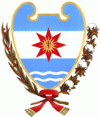Santiago del Estero Province (Santiago del Estero Province)
 |
 |
The indigenous inhabitants of these lands were the Juríes-Tonocotés, Sanavirones and other tribes. Santiago del Estero is still home to about 100,000 speakers of the local variety of Quechua, making this the southernmost outpost of the language of the Incas. When the language reached the area, and how, remains unclear—it may even have arrived only with the native troops that accompanied the first Spanish expeditions.
Diego de Rojas first reached this land in 1542. Francisco de Aguirre founded the city of Santiago del Estero in 1553 as the northernmost city founded by Spanish conquistadores coming from the Pacific Ocean.
Santiago then passed under different governments, from the intendency of Tucumán to the Audiencia de Charcas, then again to Tucumán, of which it was later to be designated capital. However, the bishop moved to Córdoba in 1699 and the government moved to Salta two years later. Furthermore, the silver route between Buenos Aires and the Viceroyalty of Peru passed through Tucumán rather than through Santiago. The combination of these circumstances drastically reduced the importance of the city and the territory and, by the beginning of the 19th century, the city had barely 5,000 inhabitants.
With the creation of the intendency of Salta, Santiago del Estero was transferred to the new intendency of Tucumán. In the middle of the national conflict, Santiago del Estero separated from Tucumán in 1820, coming under the control of pro-autonomy Governor Juan Felipe Ibarra. Among the new province's most effective advocates during its early decades was Amancio Jacinto Alcorta, a young composer of sacral music who, representing his province from 1826 to 1862, helped modernize commerce and its taxation in the unstable young nation and promoted domestic banking and credit. In 1856 the provincial constitution was formulated.
At the beginning of the 20th century Santiago del Estero acquired part of the lands that were the subject of a dispute with Chaco Province. By then the province had four cities and 35,000 inhabitants, most of whom lived in precarious conditions. The construction of the Los Quiroga dam in 1950 enabled the productivity of the otherwise arid land to be increased by irrigation. During the 1890s, national policy makers were made aware of a little-publicized tourist route northwest of the city of Santiago del Estero, whereby, despite the abject lack of transportation or lodging amenities, a steady stream of visitors rode on horseback over craggy terrain for hours for the sake of enjoying a cluster of mineral springs rarely mentioned since Spaniards had first noticed them in 1543.
The Argentine Department of Agriculture commissioned University of Buenos Aires chemistry professor Hercules Corti to study the springs. Completing his report in 1918, Corti stated that the Río Hondo Hot Springs were among the most therapeutic on earth and, coming at a time when mineral springs were becoming a leading destination for health tourism, Río Hondo quickly began attracting visitors from all over Argentina. Set aside as a public resort in 1932, the first formal hotel facilities were opened in the late 1940s.
In 1948, the province elected Peronist activist Carlos Arturo Juárez Governor of the province. Santiago del Estero's central political figure during the late 20th century, Juárez was energetic and ambitious, and he soon became indispensable to local politics (mostly by proxy). Regarded as a Caudillo, by the 1990s, was readily ordering his opponents' deaths, including those of former Governor César Iturre in 1996 and of Bishop Gerardo Sueldo in 1998.
The deaths of two local young women, however, exposed Juárez's assassin, Antonio Musa Azar, and, faced with undeniable links to Musa Azar's litany of past murders and extortions, Juárez resigned in late 2002. His wife, Nina Aragonés de Juárez, was hand-picked to replace him; she was herself removed from office by order of President Néstor Kirchner in March 2004.
Map - Santiago del Estero Province (Santiago del Estero Province)
Map
Country - Argentina
 |
 |
| Flag of Argentina | |
The earliest recorded human presence in modern-day Argentina dates back to the Paleolithic period. The Inca Empire expanded to the northwest of the country in Pre-Columbian times. The country has its roots in Spanish colonization of the region during the 16th century. Argentina rose as the successor state of the Viceroyalty of the Río de la Plata, a Spanish overseas viceroyalty founded in 1776. The declaration and fight for independence (1810–1818) was followed by an extended civil war that lasted until 1861, culminating in the country's reorganization as a federation. The country thereafter enjoyed relative peace and stability, with several waves of European immigration, mainly Italians and Spaniards, radically reshaping its cultural and demographic outlook; over 60% of the population has full or partial Italian ancestry, and Argentine culture has significant connections to Italian culture.
Currency / Language
| ISO | Currency | Symbol | Significant figures |
|---|---|---|---|
| ARS | Argentine peso | $ | 2 |
| ISO | Language |
|---|---|
| EN | English language |
| FR | French language |
| DE | German language |
| GN | Guarani language |
| IT | Italian language |
| ES | Spanish language |















